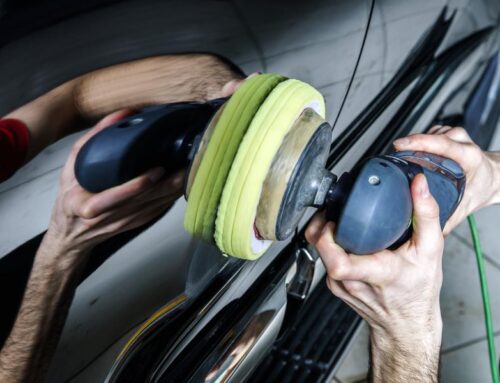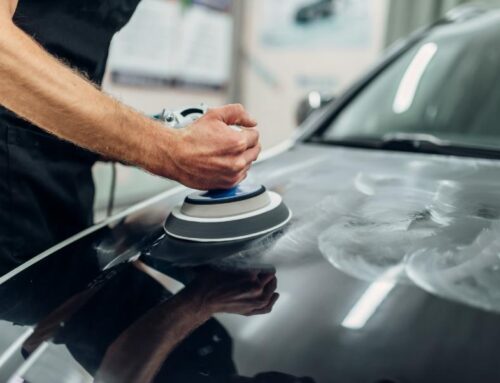Leather is a classic, timeless material that provides comfort and sophistication to your vehicle’s interior. But with age, the leather can become sticky – an issue many car owners are all too familiar with. The question of “does old leather get sticky?” has been asked time and again by those seeking answers on how to prevent or reverse this uncomfortable situation in their cars.
In this blog post, we will explore the causes of sticky leather as well as prevention tips, cleaning solutions and repair options available for tackling this problem. We’ll also discuss the benefits of professional auto detailing services when it comes to keeping your car’s upholstery looking great!
Table of Contents:
- Causes of Sticky Leather
- Prevention Tips
- Cleaning Solutions
- Repair Options
- Benefits of Professional Auto Detailing Services
- FAQs in Relation to Why Does Old Leather Get Sticky?
- Conclusion
Causes of Sticky Leather
Sticky leather is a common problem for car owners. It can be caused by several factors, including exposure to heat and humidity, lack of proper maintenance, and chemical reactions.
Heat and Humidity: Leather is a natural material that can easily absorb moisture from the air. When exposed to high temperatures or humid conditions, it will start to feel sticky as the water evaporates off its surface. This type of stickiness is usually temporary but can become permanent if not addressed promptly. To prevent this issue from occurring in the first place, make sure your vehicle’s interior temperature stays cool and dry at all times when possible.
Lack of Proper Maintenance: If you don’t regularly clean your leather seats with an appropriate cleaner designed specifically for use on leather surfaces, dirt and grime can build up over time causing them to become sticky or tacky feeling. Regularly wiping down your seats with a damp cloth should help keep them looking their best while also preventing any buildup of dirt or dust particles that could cause stickiness later on down the line.
Chemical Reactions: Certain chemicals such as oils used in cleaners or conditioners may react with the natural proteins found in leather causing it to become sticky after application even though they were intended for use on this type of material originally. To avoid this issue altogether always read product labels carefully before using any kind of cleaning agent on your car’s interior surfaces so you know exactly what ingredients are included within each one beforehand!
If your leather has already started sticking due to any of these causes mentioned above then there are still some repair options available depending upon how severe the damage is overall. For minor cases, simply wiping away excess residue left behind by oils or other products may be enough, while more serious cases might require professional repairs such as re-dying or replacing sections entirely. This would need to be done by an experienced auto detailer who specializes in working with leather materials specifically rather than just general detailing services alone.
Sticky leather is caused by a variety of factors, from improper cleaning to exposure to humidity. Taking preventative measures can help keep your car’s interior looking and feeling great for years to come. Let’s look at some tips on how to avoid sticky leather in the next section.
Prevention Tips
Leather is a luxurious material that can add sophistication and style to any vehicle. However, leather can become sticky if not properly cared for. To prevent your leather from becoming sticky, there are several steps you should take.
First, use a quality leather conditioner regularly to keep the surface of the leather soft and supple. This will help protect it from dirt and oils that could cause it to become sticky over time. Be sure to apply the conditioner in an even layer across the entire surface of the leather so that all areas receive equal protection.
Second, avoid exposing your car’s interior to direct sunlight or other heat sources such as air vents or radiators which can dry out and damage the leather causing it to stick together when touched. If possible, park in shaded areas whenever possible or use window shades on sunny days while driving around town.
Third, clean up spills immediately before they have a chance to seep into cracks between panels or seams where they may be difficult remove later on without damaging the material further. Use a damp cloth with mild soap solution (not detergent) and gently wipe away any messes before they have time set in and cause permanent staining or discoloration of your car’s interior surfaces including its leather seats and trim pieces .
Finally, consider investing in professional auto detailing services at least once per year depending on how often you drive your vehicle. This will help ensure that all parts of your car’s interior are properly cleaned including those hard-to-reach places like between seat cushions where dirt tends to accumulate over time leading eventually lead to sticky situations down the road. Professional detailers also know what products work best for each type of material used inside cars so you don’t have to worry about using the wrong product and endangering the health and safety of occupants or the vehicle itself.
By following these simple tips, you’ll be able to keep your car’s interior looking great while avoiding the dreaded problem of stuck together, dried out, cracked or broken down pieces of old worn out and dirty looking furniture.
Preventing sticky leather is key to keeping your car’s interior looking great. With the right cleaning and conditioning products, you can keep your leather in top condition. Now let’s look at some solutions for dealing with existing stickiness.
Cleaning Solutions
When it comes to cleaning sticky leather, there are a few solutions that can help. The first is using a damp cloth with mild soap or vinegar solution to remove dirt and grime buildup. This method is best for light-duty cleaning, as it won’t damage the surface of the leather. For tougher stains, you may need to use a stronger cleaner like saddle soap or an all-purpose leather cleaner. Make sure to test any product on an inconspicuous area before applying it directly onto your car’s interior surfaces.
Another option is using a soft brush such as a toothbrush or paintbrush dipped in warm water and dish detergent mixed together in equal parts. Gently scrub away at the stain until it begins to lift off from the surface of the leather seat or other material. Afterward, wipe down with clean water and dry thoroughly with a microfiber towel before allowing time for air drying completely.
Cleaning solutions can help keep your leather looking fresh and new, but sometimes repairs are needed to maintain its condition. In the next section, we’ll discuss repair options for sticky or worn out leather.
Repair Options
Sticky leather can be a frustrating problem for vehicle owners. Fortunately, there are several repair options available to help restore the look and feel of your car’s interior.
One option is to use a professional auto detailing service. Professional detailers have access to specialized cleaning solutions that can remove sticky residue without damaging the leather surface. They also have experience in applying protective sealants which will help prevent future damage from occurring.
Another option is to apply a leather sealant yourself at home. This will provide an extra layer of protection against dirt, dust, and other contaminants that may cause stickiness over time. Make sure you choose a product specifically designed for automotive leather surfaces as some products may contain harsh chemicals that could damage your car’s interior.
If the sticky residue has caused discoloration or staining on your car’s upholstery, you may need to consider using special cleaning agents such as degreasers or solvent-based cleaners to remove it completely before applying any type of sealant or protectant product. Be sure to test these products on an inconspicuous area first before using them on larger areas of your car’s interior in order avoid causing further damage by accidently discoloring the material itself instead of just removing the stain or residue from it..
Finally, if all else fails and you cannot get rid of the stickiness no matter what methods you try then it might be best to replace affected parts with new ones altogether. However, this should only be done after consulting with professionals who know how to handle such matters properly so as not to void any warranties associated with those particular parts in question while doing so correctly and safely.
Repair options can help restore the look and feel of old leather, but professional auto detailing services can provide even better results. Let’s take a look at the benefits of these services in the next heading.
Benefits of Professional Auto Detailing Services
When it comes to sticky leather, professional auto detailing services can make a huge difference. Not only do they offer deep cleaning and conditioning of the material, but they also restore its original look and feel.
One of the main benefits of professional auto detailing is that it helps remove dirt, dust, and other contaminants from your car’s interior surfaces. This includes sticky leather which can be difficult to clean on your own due to its delicate nature. Professional detailers use specialized tools and products designed specifically for this type of material so that you don’t have to worry about damaging it while trying to clean it yourself.
Professional auto detailers also provide conditioners that help protect the leather from future damage caused by UV rays or other environmental factors like humidity or extreme temperatures. These conditioners are formulated with natural oils such as lanolin or jojoba oil which penetrate into the pores of the leather creating a protective barrier against these elements without leaving behind any residue or discoloration.
Another benefit of using professional auto detailing services is their ability to repair minor damages such as scuffs, scratches, cracks, tears in the surface etc., making them look almost brand new again! Professional detailers are trained in techniques such as color matching and dyeing which allow them to blend colors together seamlessly giving your vehicle an even finish throughout all areas affected by wear-and-tear over time.
Finally, regular maintenance through professional auto detailing will keep your car looking great for years down the road. Regularly scheduled treatments will ensure that any dirt build up is removed before it has a chance to cause permanent damage while keeping all surfaces protected from further harm caused by everyday use such as spills or pet hair buildup. This way you can enjoy driving around in a beautiful car without having to worry about maintaining its appearance every few months.
FAQs in Relation to Why Does Old Leather Get Sticky?
How do you fix old sticky leather?
Sticky leather can be fixed with a few simple steps. First, use a soft cloth to wipe away any dirt or dust from the surface of the leather. Next, apply a small amount of leather conditioner onto the cloth and rub it into the leather in circular motions until it is evenly distributed. Finally, allow the conditioner to dry completely before wiping off any excess residue with another clean cloth. With these steps, your old sticky leather should be restored to its original shine and suppleness!
Is real leather sticky?
No, real leather is not sticky. Leather is a natural material that has been treated and tanned to make it more durable and resistant to moisture. It can be soft or firm depending on the tanning process used, but it should never feel sticky or tacky to the touch. Properly cared for leather will remain supple and comfortable over time with minimal maintenance required.
Can you rehydrate old leather?
Yes, it is possible to rehydrate old leather. This can be done by using a special conditioner that helps restore the natural oils and moisture of the leather. The conditioner should be applied in thin layers and left to absorb into the material for several hours before buffing with a soft cloth. It’s important to use a quality product specifically designed for this purpose as other products may damage or discolor the leather. With regular maintenance, your leather will look like new again!
How do you refresh old leather?
Leather is a material that can easily become dull and worn over time. To refresh old leather, it’s important to start by cleaning the surface with a mild soap or detergent and warm water. After cleaning, use a leather conditioner to help restore moisture and protect against cracking or fading. Finally, apply a quality leather protector to create an invisible barrier against dirt and other contaminants. With regular maintenance, your leather will look like new for years to come!
Conclusion
Leather can become sticky over time, but with the right preventive measures and cleaning solutions, you can keep your leather looking its best. Professional auto detailing services are an excellent way to ensure that your car’s interior is properly cared for. They have the knowledge and expertise to clean and protect your leather from becoming sticky or damaged in any way. So if you want to avoid having to ask “does old leather get sticky?” then make sure you invest in professional auto detailing services today!




